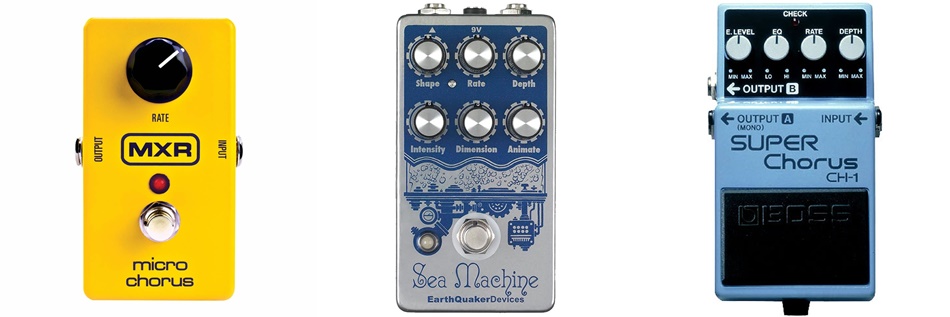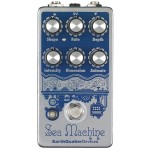Language
How The Chorus Guitar Effect Works
While it might not be as popular as it was during its heyday, slathered on what seemed like nearly every clean guitar part from the late ‘70s to the ‘80s, the chorus effect remains a staple of guitarists everywhere. Known for the watery, shimmering sound it imbues onto a guitar’s tone, the chorus effect has been used on some of the most iconic tracks in the history of rock. Today, we’re going to take a closer look at what the chorus effect is and how it works, as well as a few great chorus pedals that we feel deserve a closer look.
 From Left: MXR M148 Micro Chorus, EarthQuaker SeaMachine V2 and the Boss CH-1 Super Chorus.[/caption]
MXR M148 Micro Chorus: Designed with the same old-school bucket brigade chip that graced some of the most popular chorus effects of the '80s, the Micro Chorus is perfect for fans of classic chorus. With rich textures that range a watery shimmer to intense rotating speaker simulation, the Micro Chorus is a versatile pedal that offers plenty of value for less than $100.
EarthQuaker Devices SeaMachine V2 Chorus: If having complete control of your sound is more your thing, the SeaMachine is a great choice. With settings that let you manipulate everything from the shape of the signal wave to the modulation of the delay time and then some, the SeaMachine is perfect for crafting your signature chorus effect.
Boss CH-1 Super Chorus: Like many other Boss pedals, the CH-1 is a time tested classic that offers amazing tone at an amazing price. Able to deliver a clean classic chorus sound with crystal-clear highs and a unique stereo effect (variable between left and right speakers), the Ch-1 Super Chorus offers plenty of value.
Click here to check our our selection of Chorus Effects Pedals.
Hopefully this article has shed some light on the inner workings of the chorus effect to give you a better idea on what it can add to your sound. While it might not be for everyone, the chorus effect remains a classic with clean tone guitarists everywhere.
If you have any questions regarding the purchase or the pedals above or any other piece of gear, don't hesitate to talk to one of our helpful PAL pros by using the contact us dialogue box below!
From Left: MXR M148 Micro Chorus, EarthQuaker SeaMachine V2 and the Boss CH-1 Super Chorus.[/caption]
MXR M148 Micro Chorus: Designed with the same old-school bucket brigade chip that graced some of the most popular chorus effects of the '80s, the Micro Chorus is perfect for fans of classic chorus. With rich textures that range a watery shimmer to intense rotating speaker simulation, the Micro Chorus is a versatile pedal that offers plenty of value for less than $100.
EarthQuaker Devices SeaMachine V2 Chorus: If having complete control of your sound is more your thing, the SeaMachine is a great choice. With settings that let you manipulate everything from the shape of the signal wave to the modulation of the delay time and then some, the SeaMachine is perfect for crafting your signature chorus effect.
Boss CH-1 Super Chorus: Like many other Boss pedals, the CH-1 is a time tested classic that offers amazing tone at an amazing price. Able to deliver a clean classic chorus sound with crystal-clear highs and a unique stereo effect (variable between left and right speakers), the Ch-1 Super Chorus offers plenty of value.
Click here to check our our selection of Chorus Effects Pedals.
Hopefully this article has shed some light on the inner workings of the chorus effect to give you a better idea on what it can add to your sound. While it might not be for everyone, the chorus effect remains a classic with clean tone guitarists everywhere.
If you have any questions regarding the purchase or the pedals above or any other piece of gear, don't hesitate to talk to one of our helpful PAL pros by using the contact us dialogue box below!
What It Is
It simplest terms, the chorus effect can be described as sounding as if two instruments are performing the same part at the same time. But unlike delay, the key to the chorus effect are the subtle variations between the two parts. Think of it like a choir: while there are multiple voices singing the same piece, no two voices are perfectly alike, creating slight variations in pitch, tone and even phrasing. These small variations produce a voice that sounds thicker and fuller than what you would be able to create with just one voice. The differences between the voices “smear” the sound, resulting in a bigger, more complex overall sound. Throw in some more voices and pan them around a stereo field and you get a very spacious sound.How The Chorus Effect Works
As far as guitars go, you would need two guitarists playing very tight with one another to get something similar, but it still wouldn’t come close to the complex overtones created in our choir example. Luckily, the chorus effect was built to give guitars that same spacious sound. It works by taking a guitar signal, applying a short delay, then slightly altering the timing of the delay at regular intervals. After that, it then mixes this augmented signal with the original, unaltered signal. You can think of it like playing while someone is twisting the timing knob on a delay pedal back and forth; the pitch speeds up when the delay time is decreased and drops as the delay time is increased (which would result in sort of “spaceship taking off” sound).” Now, imagine the same thing but in very small increments, smaller than your hand would be able to pull off, and with perfect consistency. While this altered signal might sound like a simple vibrato on its own, when mixed with a clean signal and spread out over a stereo field, it creates that watery, spacious sound chorus pedals are known for.A Few Great Chorus Pedals
[caption id="attachment_5249" align="alignnone" width="950"] From Left: MXR M148 Micro Chorus, EarthQuaker SeaMachine V2 and the Boss CH-1 Super Chorus.[/caption]
MXR M148 Micro Chorus: Designed with the same old-school bucket brigade chip that graced some of the most popular chorus effects of the '80s, the Micro Chorus is perfect for fans of classic chorus. With rich textures that range a watery shimmer to intense rotating speaker simulation, the Micro Chorus is a versatile pedal that offers plenty of value for less than $100.
EarthQuaker Devices SeaMachine V2 Chorus: If having complete control of your sound is more your thing, the SeaMachine is a great choice. With settings that let you manipulate everything from the shape of the signal wave to the modulation of the delay time and then some, the SeaMachine is perfect for crafting your signature chorus effect.
Boss CH-1 Super Chorus: Like many other Boss pedals, the CH-1 is a time tested classic that offers amazing tone at an amazing price. Able to deliver a clean classic chorus sound with crystal-clear highs and a unique stereo effect (variable between left and right speakers), the Ch-1 Super Chorus offers plenty of value.
Click here to check our our selection of Chorus Effects Pedals.
Hopefully this article has shed some light on the inner workings of the chorus effect to give you a better idea on what it can add to your sound. While it might not be for everyone, the chorus effect remains a classic with clean tone guitarists everywhere.
If you have any questions regarding the purchase or the pedals above or any other piece of gear, don't hesitate to talk to one of our helpful PAL pros by using the contact us dialogue box below!
From Left: MXR M148 Micro Chorus, EarthQuaker SeaMachine V2 and the Boss CH-1 Super Chorus.[/caption]
MXR M148 Micro Chorus: Designed with the same old-school bucket brigade chip that graced some of the most popular chorus effects of the '80s, the Micro Chorus is perfect for fans of classic chorus. With rich textures that range a watery shimmer to intense rotating speaker simulation, the Micro Chorus is a versatile pedal that offers plenty of value for less than $100.
EarthQuaker Devices SeaMachine V2 Chorus: If having complete control of your sound is more your thing, the SeaMachine is a great choice. With settings that let you manipulate everything from the shape of the signal wave to the modulation of the delay time and then some, the SeaMachine is perfect for crafting your signature chorus effect.
Boss CH-1 Super Chorus: Like many other Boss pedals, the CH-1 is a time tested classic that offers amazing tone at an amazing price. Able to deliver a clean classic chorus sound with crystal-clear highs and a unique stereo effect (variable between left and right speakers), the Ch-1 Super Chorus offers plenty of value.
Click here to check our our selection of Chorus Effects Pedals.
Hopefully this article has shed some light on the inner workings of the chorus effect to give you a better idea on what it can add to your sound. While it might not be for everyone, the chorus effect remains a classic with clean tone guitarists everywhere.
If you have any questions regarding the purchase or the pedals above or any other piece of gear, don't hesitate to talk to one of our helpful PAL pros by using the contact us dialogue box below!

